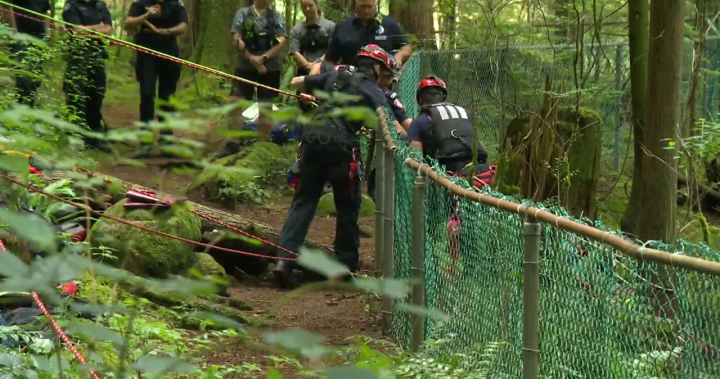A 17-year-old boy from Ontario died at Lynn Canyon on Vancouver’s North Shore after ignoring signs and climbing past a broken fence. He fell about 150 feet into the canyon. The teen was expected to start classes at the University of British Columbia the following week. The coroner is investigating the incident. Dwayne Derban, assistant chief of operations at the District of North Vancouver Fire and Rescue, mentioned that the call came in at 3 p.m. on Sunday. The first-on-the-scene crew had to locate the teen’s friends who were off-trail before finding the young man who had fallen over the cliff. There was a delay before the friends called 911 as they initially thought he was okay.
Derban mentioned that the boy’s friends explained he had gone over the fence and close to the edge to take pictures when the ground gave way, causing him to fall. The fall was about 150 feet. Once it was determined that there was no life to be saved, the operation switched to recovery mode involving the RCMP and the coroner. Derban had to inform the young man’s friends about what had happened. He shared a personal connection to the incident, as his uncle had lost his life in a similar manner at Lynn Canyon 80 years ago. Derban emphasized that the dangerous areas are all fenced off and that people should not venture beyond them without caution and attention.
The incident at Lynn Canyon serves as a reminder of the dangers of ignoring warning signs and fences around natural areas. Despite the presence of barriers indicating where visitors should not go, the teenager chose to climb over and lost his footing, resulting in a tragic fall. Dwayne Derban of the District of North Vancouver Fire and Rescue highlighted the importance of respecting safety measures put in place at popular tourist spots like Lynn Canyon. He also shared a personal connection to the tragedy, noting that his family had experienced a similar loss in the past.
Derban’s experience with his uncle’s death at Lynn Canyon underscores the long-standing risks associated with venturing off-trail or beyond designated areas in natural parks. The tragic outcome of the recent incident reiterates the need for visitors to exercise caution and follow safety guidelines when exploring such locations. The involvement of emergency response teams like the District of North Vancouver Fire and Rescue demonstrates the rapid and coordinated efforts required to handle such emergencies effectively. The transition from a rescue mission to a recovery operation highlights the grim reality faced by first responders in such situations.
The incident also sheds light on the emotional toll that such tragedies can have on the loved ones left behind, as seen in Derban’s experience of informing the young man’s friends about his passing. The interconnectedness of past and present losses in the same area serves as a poignant reminder of the enduring impact of such accidents on individuals and communities. Derban’s plea for visitors to exercise care and attention in such areas reinforces the importance of responsible behavior when interacting with nature. The emphasis on safety measures and the role of park rangers in monitoring and securing dangerous areas underscores the ongoing efforts to prevent similar accidents in the future.
In conclusion, the recent death at Lynn Canyon serves as a sobering reminder of the risks associated with disregarding safety guidelines in natural settings. The incident highlights the need for visitors to prioritize their safety and that of others by adhering to designated paths and barriers. The prompt response from emergency services and the subsequent investigation by the coroner underscore the importance of a coordinated and comprehensive approach to handling such incidents. The impact on families, responders, and communities affected by such tragedies emphasizes the far-reaching consequences of individual decisions in potentially hazardous environments. Ultimately, the message to exercise caution and respect safety measures in natural parks like Lynn Canyon remains vital in promoting visitor safety and preventing further accidents.


